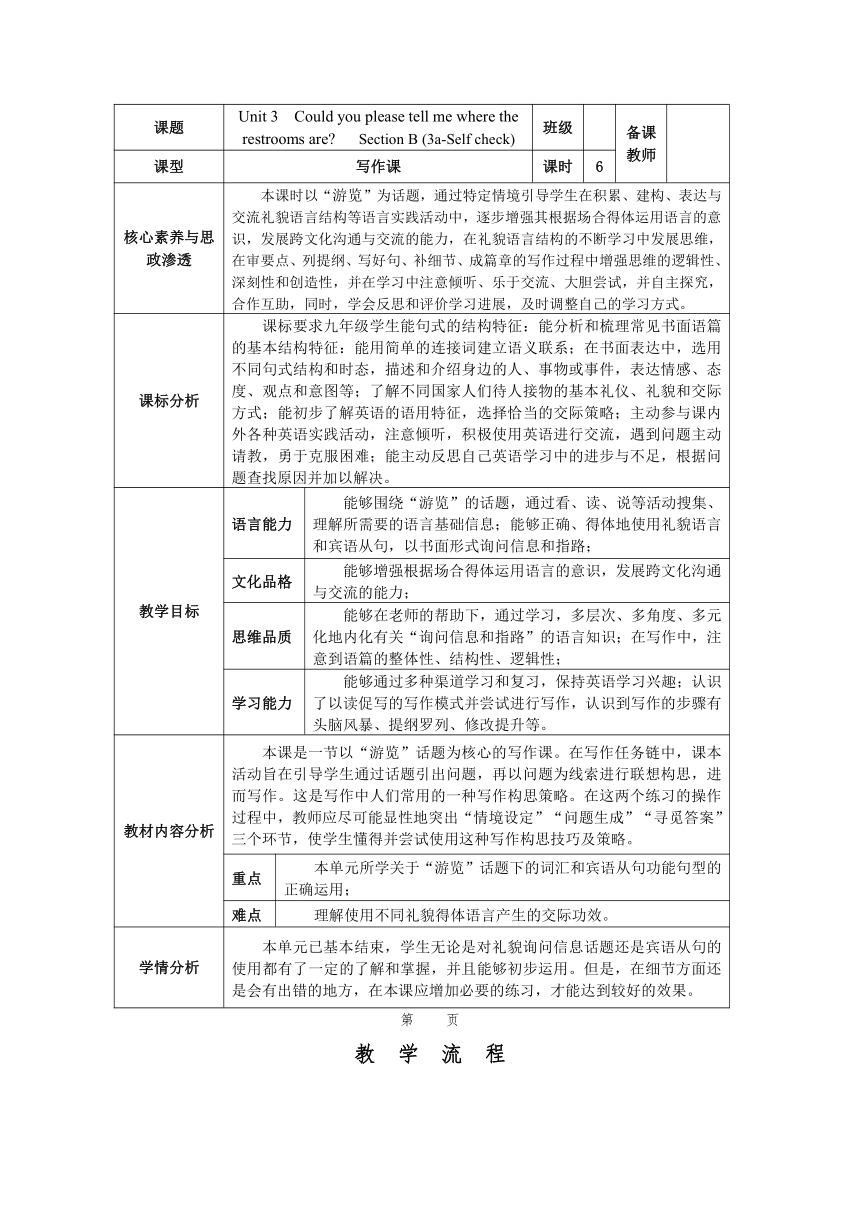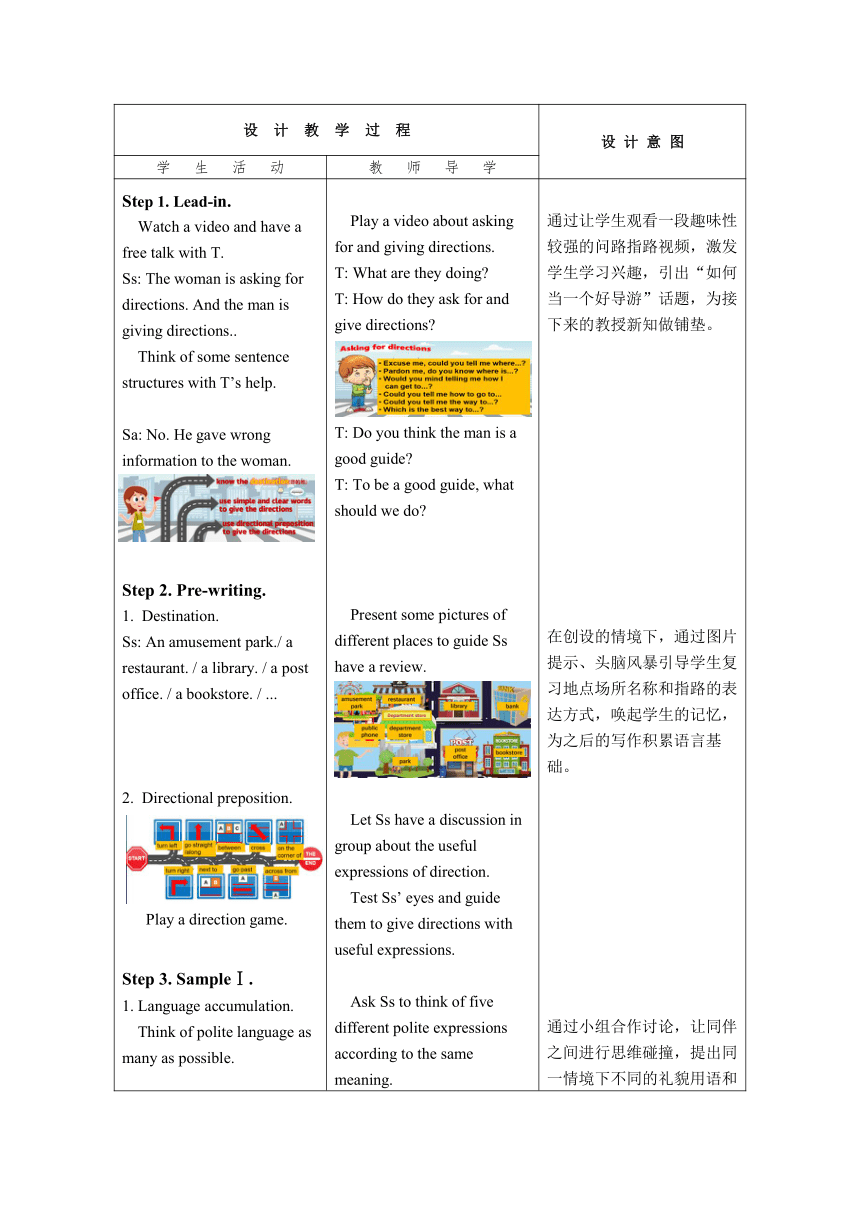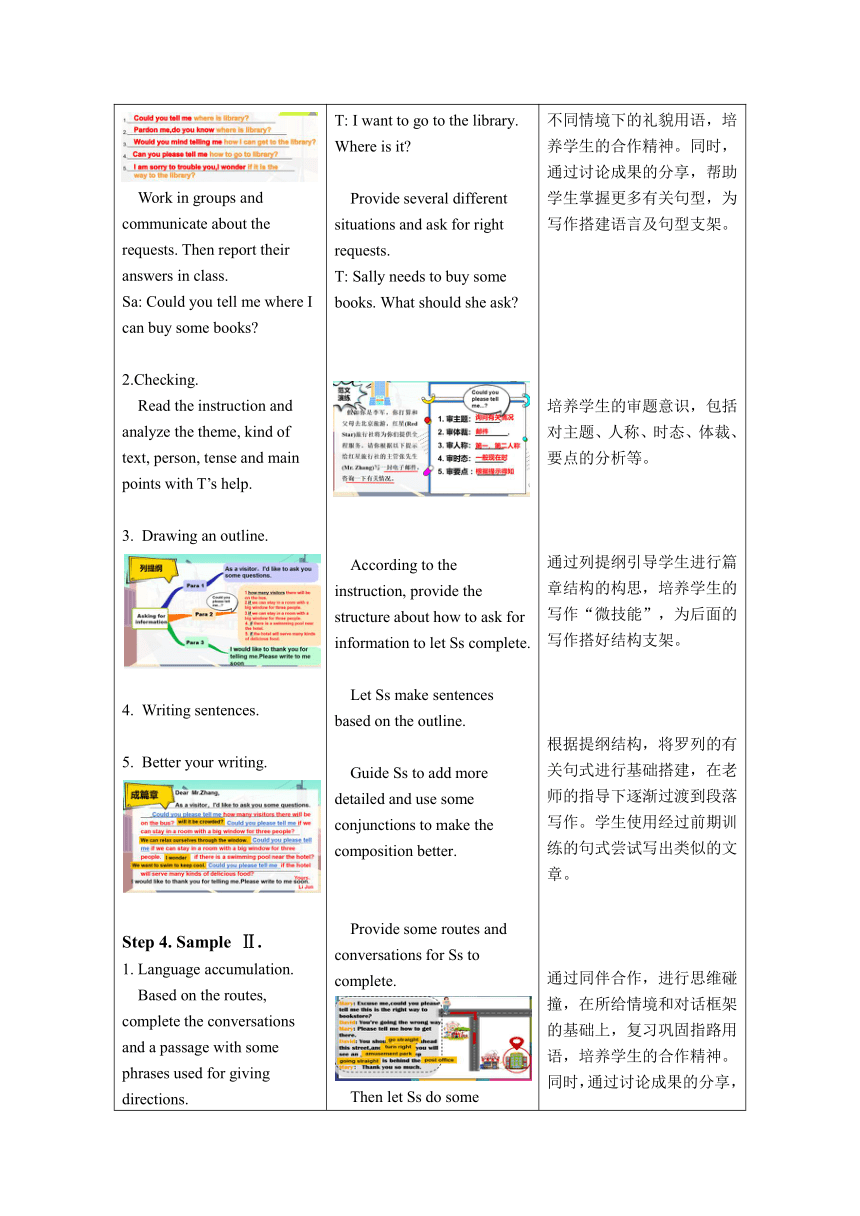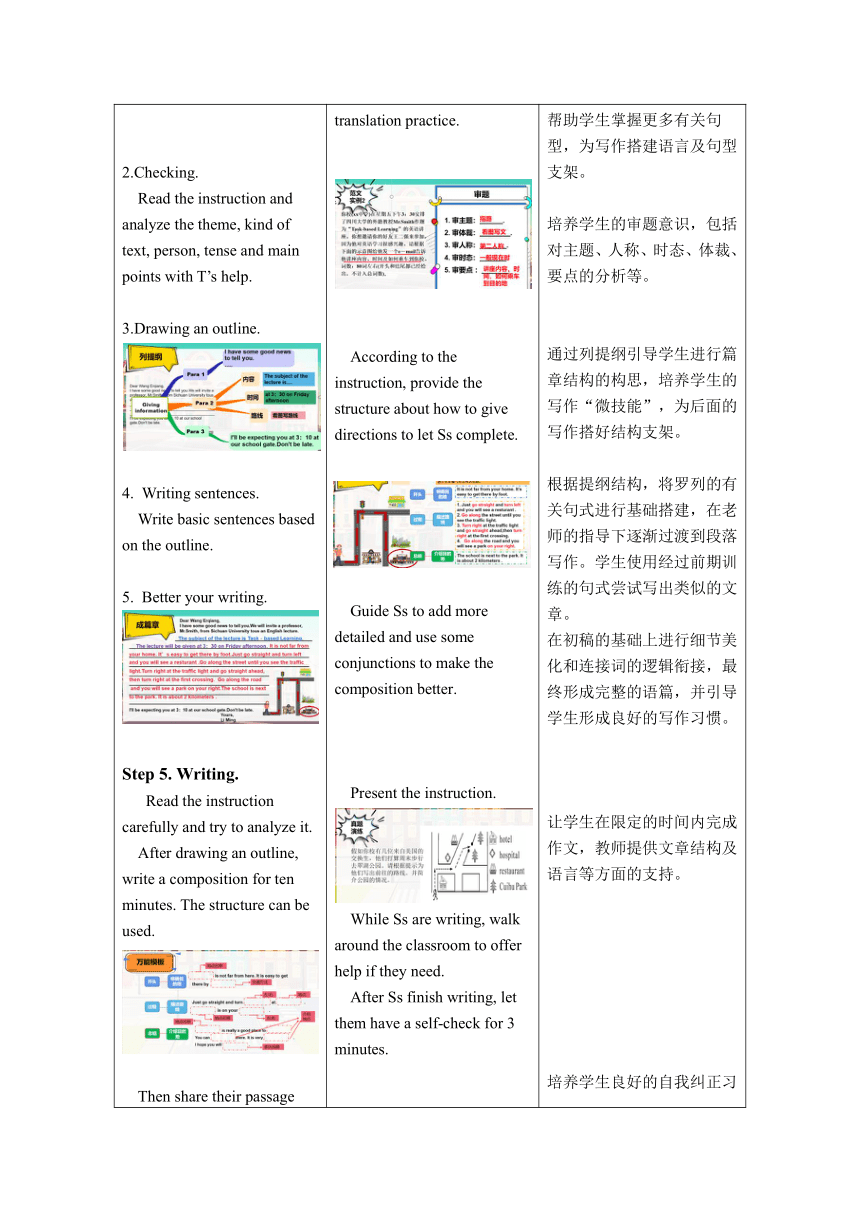【核心素养目标】Unit 3 Could you please tell me where the restrooms are Section B (3a-Self check)表格式教案
文档属性
| 名称 | 【核心素养目标】Unit 3 Could you please tell me where the restrooms are Section B (3a-Self check)表格式教案 |  | |
| 格式 | docx | ||
| 文件大小 | 1.5MB | ||
| 资源类型 | 教案 | ||
| 版本资源 | 人教新目标(Go for it)版 | ||
| 科目 | 英语 | ||
| 更新时间 | 2024-09-24 09:36:00 | ||
图片预览




文档简介
课题 Unit 3 Could you please tell me where the restrooms are Section B (3a-Self check) 班级 备课教师
课型 写作课 课时 6
核心素养与思政渗透 本课时以“游览”为话题,通过特定情境引导学生在积累、建构、表达与交流礼貌语言结构等语言实践活动中,逐步增强其根据场合得体运用语言的意识,发展跨文化沟通与交流的能力,在礼貌语言结构的不断学习中发展思维,在审要点、列提纲、写好句、补细节、成篇章的写作过程中增强思维的逻辑性、深刻性和创造性,并在学习中注意倾听、乐于交流、大胆尝试,并自主探究,合作互助,同时,学会反思和评价学习进展,及时调整自己的学习方式。
课标分析 课标要求九年级学生能句式的结构特征:能分析和梳理常见书面语篇的基本结构特征:能用简单的连接词建立语义联系;在书面表达中,选用不同句式结构和时态,描述和介绍身边的人、事物或事件,表达情感、态度、观点和意图等;了解不同国家人们待人接物的基本礼仪、礼貌和交际方式;能初步了解英语的语用特征,选择恰当的交际策略;主动参与课内外各种英语实践活动,注意倾听,积极使用英语进行交流,遇到问题主动请教,勇于克服困难;能主动反思自己英语学习中的进步与不足,根据问题查找原因并加以解决。
教学目标 语言能力 能够围绕“游览”的话题,通过看、读、说等活动搜集、理解所需要的语言基础信息;能够正确、得体地使用礼貌语言和宾语从句,以书面形式询问信息和指路;
文化品格 能够增强根据场合得体运用语言的意识,发展跨文化沟通与交流的能力;
思维品质 能够在老师的帮助下,通过学习,多层次、多角度、多元化地内化有关“询问信息和指路”的语言知识;在写作中,注意到语篇的整体性、结构性、逻辑性;
学习能力 能够通过多种渠道学习和复习,保持英语学习兴趣;认识了以读促写的写作模式并尝试进行写作,认识到写作的步骤有头脑风暴、提纲罗列、修改提升等。
教材内容分析 本课是一节以“游览”话题为核心的写作课。在写作任务链中,课本活动旨在引导学生通过话题引出问题,再以问题为线索进行联想构思,进而写作。这是写作中人们常用的一种写作构思策略。在这两个练习的操作过程中,教师应尽可能显性地突出“情境设定”“问题生成”“寻觅答案”三个环节,使学生懂得并尝试使用这种写作构思技巧及策略。
重点 本单元所学关于“游览”话题下的词汇和宾语从句功能句型的正确运用;
难点 理解使用不同礼貌得体语言产生的交际功效。
学情分析 本单元已基本结束,学生无论是对礼貌询问信息话题还是宾语从句的使用都有了一定的了解和掌握,并且能够初步运用。但是,在细节方面还是会有出错的地方,在本课应增加必要的练习,才能达到较好的效果。
第 页
教 学 流 程
设 计 教 学 过 程 设 计 意 图
学 生 活 动 教 师 导 学
Step 1. Lead-in. Watch a video and have a free talk with T. Ss: The woman is asking for directions. And the man is giving directions.. Think of some sentence structures with T’s help. Sa: No. He gave wrong information to the woman. Step 2. Pre-writing. Destination. Ss: An amusement park./ a restaurant. / a library. / a post office. / a bookstore. / ... Directional preposition. Play a direction game. Step 3. SampleⅠ. 1. Language accumulation. Think of polite language as many as possible. Work in groups and communicate about the requests. Then report their answers in class. Sa: Could you tell me where I can buy some books 2.Checking. Read the instruction and analyze the theme, kind of text, person, tense and main points with T’s help. Drawing an outline. Writing sentences. Better your writing. Step 4. Sample Ⅱ. 1. Language accumulation. Based on the routes, complete the conversations and a passage with some phrases used for giving directions. 2.Checking. Read the instruction and analyze the theme, kind of text, person, tense and main points with T’s help. 3.Drawing an outline. Writing sentences. Write basic sentences based on the outline. Better your writing. Step 5. Writing. Read the instruction carefully and try to analyze it. After drawing an outline, write a composition for ten minutes. The structure can be used. Then share their passage with partners and evaluate each other according to the evaluation sheet. Appreciate the sample writing and sum up what a good article needs. Step 6. Self check. Finish the self check part. Report their answers and talk about their reasons. Play a video about asking for and giving directions. T: What are they doing T: How do they ask for and give directions T: Do you think the man is a good guide T: To be a good guide, what should we do Present some pictures of different places to guide Ss have a review. Let Ss have a discussion in group about the useful expressions of direction. Test Ss’ eyes and guide them to give directions with useful expressions. Ask Ss to think of five different polite expressions according to the same meaning. T: I want to go to the library. Where is it Provide several different situations and ask for right requests. T: Sally needs to buy some books. What should she ask According to the instruction, provide the structure about how to ask for information to let Ss complete. Let Ss make sentences based on the outline. Guide Ss to add more detailed and use some conjunctions to make the composition better. Provide some routes and conversations for Ss to complete. Then let Ss do some translation practice. According to the instruction, provide the structure about how to give directions to let Ss complete. Guide Ss to add more detailed and use some conjunctions to make the composition better. Present the instruction. While Ss are writing, walk around the classroom to offer help if they need. After Ss finish writing, let them have a self-check for 3 minutes. Pick out one or two examples to evaluate in class. 通过让学生观看一段趣味性较强的问路指路视频,激发学生学习兴趣,引出“如何当一个好导游”话题,为接下来的教授新知做铺垫。 在创设的情境下,通过图片提示、头脑风暴引导学生复习地点场所名称和指路的表达方式,唤起学生的记忆,为之后的写作积累语言基础。 通过小组合作讨论,让同伴之间进行思维碰撞,提出同一情境下不同的礼貌用语和不同情境下的礼貌用语,培养学生的合作精神。同时,通过讨论成果的分享,帮助学生掌握更多有关句型,为写作搭建语言及句型支架。 培养学生的审题意识,包括对主题、人称、时态、体裁、要点的分析等。 通过列提纲引导学生进行篇章结构的构思,培养学生的写作“微技能”,为后面的写作搭好结构支架。 根据提纲结构,将罗列的有关句式进行基础搭建,在老师的指导下逐渐过渡到段落写作。学生使用经过前期训练的句式尝试写出类似的文章。 通过同伴合作,进行思维碰撞,在所给情境和对话框架的基础上,复习巩固指路用语,培养学生的合作精神。同时,通过讨论成果的分享,帮助学生掌握更多有关句型,为写作搭建语言及句型支架。 培养学生的审题意识,包括对主题、人称、时态、体裁、要点的分析等。 通过列提纲引导学生进行篇章结构的构思,培养学生的写作“微技能”,为后面的写作搭好结构支架。 根据提纲结构,将罗列的有关句式进行基础搭建,在老师的指导下逐渐过渡到段落写作。学生使用经过前期训练的句式尝试写出类似的文章。 在初稿的基础上进行细节美化和连接词的逻辑衔接,最终形成完整的语篇,并引导学生形成良好的写作习惯。 让学生在限定的时间内完成作文,教师提供文章结构及语言等方面的支持。 培养学生良好的自我纠正习惯和方法,以及合作精神、批判思维能力和对作品的鉴赏能力。 在自我修改和同伴修改的基础上,集思广益,取其精华,学会运用更多的方法把文章写好。
第 页
课 时 达 标 检 测
Ⅰ. 选词填空 choice,corner,plan,suggest,third
Because of the universal two﹣child policy,the young couple in our school to have a second child. ﹣Which is the best clothes store in town? ﹣I Fashion Clothes.It serves clothes with the best quality. This is Mary's time to visit the beautiful city. You should think twice before making an important . There is an old piano in the of the living room. Ⅱ. 阅读理解 Some people have a very poor sense of direction. Unluckily, I am one of them. I have visited a place many times but I may still get lost there the next time. When I was a little girl, I never dared to ask strangers the way. So I often walked in circles, hoping to get where I was going by chance. Now, I am no longer too shy to ask for directions, but I often receive helpless or even wrong information. So I try to avoid giving people wrong directions. If anyone asks me the way somewhere, I would say, "sorry, I am a stranger here. " Once on my way to work, I was stopped by a man. He asked me if I could tell him the way to the Friendship Building. I gave him my usual reply. But just as I walked on only a few steps, I realized that he had asked the way to my office building. However, I had no time to turn back and look for him. I was rushing to meet with someone at my office and I didn't want to keep him waiting. When I just got to my office, the secretary showed in the man who had asked me for directions. Imagine how embarrassed I was and how surprised he was when we saw each other at the first sight! The writer always refuses to give people directions because . A. she is a stranger to the city B. she doesn't know the people C. she has no time to help others D. she's afraid of giving wrong directions 7. A man stopped the writer on the way to . A. sell her something B. ask her the time C. make friends with her D. ask for the direction 8. The Friendship Building is the place where the writer . A. lives B. studies C. works D. teaches 9. The word "embarrassed" in the last paragraph means " ". A.尴尬的 B. 困惑的 C. 激动的 D. 拮据的 10. Which of the following is TRUE according to the passage? A.The writer is too shy to give others directions. B.The writer has a very poor sense of direction. C.The writer never got lost when she was young. D.The man was quite nervous when he saw the writer.
第 页
课 时 教 学 设 计 尾 页
板 书 设 计
Unit 3 Could you please tell me where the restrooms are (Section B 3a-Self check)
作 业 设 计
Level A Work in group and make a brochure of the places of interest of our city, including maps and guide.
Level B Draw a mind map to sum up the knowledge of this unit.
教 学 反 思
第 页
课型 写作课 课时 6
核心素养与思政渗透 本课时以“游览”为话题,通过特定情境引导学生在积累、建构、表达与交流礼貌语言结构等语言实践活动中,逐步增强其根据场合得体运用语言的意识,发展跨文化沟通与交流的能力,在礼貌语言结构的不断学习中发展思维,在审要点、列提纲、写好句、补细节、成篇章的写作过程中增强思维的逻辑性、深刻性和创造性,并在学习中注意倾听、乐于交流、大胆尝试,并自主探究,合作互助,同时,学会反思和评价学习进展,及时调整自己的学习方式。
课标分析 课标要求九年级学生能句式的结构特征:能分析和梳理常见书面语篇的基本结构特征:能用简单的连接词建立语义联系;在书面表达中,选用不同句式结构和时态,描述和介绍身边的人、事物或事件,表达情感、态度、观点和意图等;了解不同国家人们待人接物的基本礼仪、礼貌和交际方式;能初步了解英语的语用特征,选择恰当的交际策略;主动参与课内外各种英语实践活动,注意倾听,积极使用英语进行交流,遇到问题主动请教,勇于克服困难;能主动反思自己英语学习中的进步与不足,根据问题查找原因并加以解决。
教学目标 语言能力 能够围绕“游览”的话题,通过看、读、说等活动搜集、理解所需要的语言基础信息;能够正确、得体地使用礼貌语言和宾语从句,以书面形式询问信息和指路;
文化品格 能够增强根据场合得体运用语言的意识,发展跨文化沟通与交流的能力;
思维品质 能够在老师的帮助下,通过学习,多层次、多角度、多元化地内化有关“询问信息和指路”的语言知识;在写作中,注意到语篇的整体性、结构性、逻辑性;
学习能力 能够通过多种渠道学习和复习,保持英语学习兴趣;认识了以读促写的写作模式并尝试进行写作,认识到写作的步骤有头脑风暴、提纲罗列、修改提升等。
教材内容分析 本课是一节以“游览”话题为核心的写作课。在写作任务链中,课本活动旨在引导学生通过话题引出问题,再以问题为线索进行联想构思,进而写作。这是写作中人们常用的一种写作构思策略。在这两个练习的操作过程中,教师应尽可能显性地突出“情境设定”“问题生成”“寻觅答案”三个环节,使学生懂得并尝试使用这种写作构思技巧及策略。
重点 本单元所学关于“游览”话题下的词汇和宾语从句功能句型的正确运用;
难点 理解使用不同礼貌得体语言产生的交际功效。
学情分析 本单元已基本结束,学生无论是对礼貌询问信息话题还是宾语从句的使用都有了一定的了解和掌握,并且能够初步运用。但是,在细节方面还是会有出错的地方,在本课应增加必要的练习,才能达到较好的效果。
第 页
教 学 流 程
设 计 教 学 过 程 设 计 意 图
学 生 活 动 教 师 导 学
Step 1. Lead-in. Watch a video and have a free talk with T. Ss: The woman is asking for directions. And the man is giving directions.. Think of some sentence structures with T’s help. Sa: No. He gave wrong information to the woman. Step 2. Pre-writing. Destination. Ss: An amusement park./ a restaurant. / a library. / a post office. / a bookstore. / ... Directional preposition. Play a direction game. Step 3. SampleⅠ. 1. Language accumulation. Think of polite language as many as possible. Work in groups and communicate about the requests. Then report their answers in class. Sa: Could you tell me where I can buy some books 2.Checking. Read the instruction and analyze the theme, kind of text, person, tense and main points with T’s help. Drawing an outline. Writing sentences. Better your writing. Step 4. Sample Ⅱ. 1. Language accumulation. Based on the routes, complete the conversations and a passage with some phrases used for giving directions. 2.Checking. Read the instruction and analyze the theme, kind of text, person, tense and main points with T’s help. 3.Drawing an outline. Writing sentences. Write basic sentences based on the outline. Better your writing. Step 5. Writing. Read the instruction carefully and try to analyze it. After drawing an outline, write a composition for ten minutes. The structure can be used. Then share their passage with partners and evaluate each other according to the evaluation sheet. Appreciate the sample writing and sum up what a good article needs. Step 6. Self check. Finish the self check part. Report their answers and talk about their reasons. Play a video about asking for and giving directions. T: What are they doing T: How do they ask for and give directions T: Do you think the man is a good guide T: To be a good guide, what should we do Present some pictures of different places to guide Ss have a review. Let Ss have a discussion in group about the useful expressions of direction. Test Ss’ eyes and guide them to give directions with useful expressions. Ask Ss to think of five different polite expressions according to the same meaning. T: I want to go to the library. Where is it Provide several different situations and ask for right requests. T: Sally needs to buy some books. What should she ask According to the instruction, provide the structure about how to ask for information to let Ss complete. Let Ss make sentences based on the outline. Guide Ss to add more detailed and use some conjunctions to make the composition better. Provide some routes and conversations for Ss to complete. Then let Ss do some translation practice. According to the instruction, provide the structure about how to give directions to let Ss complete. Guide Ss to add more detailed and use some conjunctions to make the composition better. Present the instruction. While Ss are writing, walk around the classroom to offer help if they need. After Ss finish writing, let them have a self-check for 3 minutes. Pick out one or two examples to evaluate in class. 通过让学生观看一段趣味性较强的问路指路视频,激发学生学习兴趣,引出“如何当一个好导游”话题,为接下来的教授新知做铺垫。 在创设的情境下,通过图片提示、头脑风暴引导学生复习地点场所名称和指路的表达方式,唤起学生的记忆,为之后的写作积累语言基础。 通过小组合作讨论,让同伴之间进行思维碰撞,提出同一情境下不同的礼貌用语和不同情境下的礼貌用语,培养学生的合作精神。同时,通过讨论成果的分享,帮助学生掌握更多有关句型,为写作搭建语言及句型支架。 培养学生的审题意识,包括对主题、人称、时态、体裁、要点的分析等。 通过列提纲引导学生进行篇章结构的构思,培养学生的写作“微技能”,为后面的写作搭好结构支架。 根据提纲结构,将罗列的有关句式进行基础搭建,在老师的指导下逐渐过渡到段落写作。学生使用经过前期训练的句式尝试写出类似的文章。 通过同伴合作,进行思维碰撞,在所给情境和对话框架的基础上,复习巩固指路用语,培养学生的合作精神。同时,通过讨论成果的分享,帮助学生掌握更多有关句型,为写作搭建语言及句型支架。 培养学生的审题意识,包括对主题、人称、时态、体裁、要点的分析等。 通过列提纲引导学生进行篇章结构的构思,培养学生的写作“微技能”,为后面的写作搭好结构支架。 根据提纲结构,将罗列的有关句式进行基础搭建,在老师的指导下逐渐过渡到段落写作。学生使用经过前期训练的句式尝试写出类似的文章。 在初稿的基础上进行细节美化和连接词的逻辑衔接,最终形成完整的语篇,并引导学生形成良好的写作习惯。 让学生在限定的时间内完成作文,教师提供文章结构及语言等方面的支持。 培养学生良好的自我纠正习惯和方法,以及合作精神、批判思维能力和对作品的鉴赏能力。 在自我修改和同伴修改的基础上,集思广益,取其精华,学会运用更多的方法把文章写好。
第 页
课 时 达 标 检 测
Ⅰ. 选词填空 choice,corner,plan,suggest,third
Because of the universal two﹣child policy,the young couple in our school to have a second child. ﹣Which is the best clothes store in town? ﹣I Fashion Clothes.It serves clothes with the best quality. This is Mary's time to visit the beautiful city. You should think twice before making an important . There is an old piano in the of the living room. Ⅱ. 阅读理解 Some people have a very poor sense of direction. Unluckily, I am one of them. I have visited a place many times but I may still get lost there the next time. When I was a little girl, I never dared to ask strangers the way. So I often walked in circles, hoping to get where I was going by chance. Now, I am no longer too shy to ask for directions, but I often receive helpless or even wrong information. So I try to avoid giving people wrong directions. If anyone asks me the way somewhere, I would say, "sorry, I am a stranger here. " Once on my way to work, I was stopped by a man. He asked me if I could tell him the way to the Friendship Building. I gave him my usual reply. But just as I walked on only a few steps, I realized that he had asked the way to my office building. However, I had no time to turn back and look for him. I was rushing to meet with someone at my office and I didn't want to keep him waiting. When I just got to my office, the secretary showed in the man who had asked me for directions. Imagine how embarrassed I was and how surprised he was when we saw each other at the first sight! The writer always refuses to give people directions because . A. she is a stranger to the city B. she doesn't know the people C. she has no time to help others D. she's afraid of giving wrong directions 7. A man stopped the writer on the way to . A. sell her something B. ask her the time C. make friends with her D. ask for the direction 8. The Friendship Building is the place where the writer . A. lives B. studies C. works D. teaches 9. The word "embarrassed" in the last paragraph means " ". A.尴尬的 B. 困惑的 C. 激动的 D. 拮据的 10. Which of the following is TRUE according to the passage? A.The writer is too shy to give others directions. B.The writer has a very poor sense of direction. C.The writer never got lost when she was young. D.The man was quite nervous when he saw the writer.
第 页
课 时 教 学 设 计 尾 页
板 书 设 计
Unit 3 Could you please tell me where the restrooms are (Section B 3a-Self check)
作 业 设 计
Level A Work in group and make a brochure of the places of interest of our city, including maps and guide.
Level B Draw a mind map to sum up the knowledge of this unit.
教 学 反 思
第 页
同课章节目录
- Unit 1 How can we become good learners.
- Section A
- Section B
- Unit 2 I think that mooncakes are delicious!
- Section A
- Section B
- Unit 3 Could you please tell me where the restroom
- Section A
- Section B
- Unit 4 I used to be afraid of the dark.
- Section A
- Section B
- Unit 5 What are the shirts made of?
- Section A
- Section B
- Review of Units 1-5
- Unit 6 When was it invented?
- Section A
- Section B
- Unit 7 Teenagers should be allowed to choose their
- Section A
- Section B
- Unit 8 It must belong to Carla.
- Section A
- Section B
- Unit 9 I like music that I can dance to.
- Section A
- Section B
- Unit 10 You're supposed to shake hands.
- Section A
- Section B
- Review of Units 6-10
- Unit 11 Sad movies make me cry.
- Section A
- Section B
- Unit 12 Life is full of the unexpected
- Section A
- Section B
- Unit 13 We're trying to save the earth!
- Section A
- Section B
- Unit 14 I remember meeting all of you in Grade 7.
- Section A
- Section B
- Review of Units 11-14
